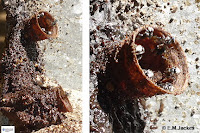Trigona sp., commonly called Sugarbag bee, Stingless bee, Sweat bee or Meliponini are a large group of bees, including Meliponini tribe (or subtribe Meliponini by other authors). Belong to the family Apidae, and closely related to common bees, carpenter bees, bumble and orchid bees. The common name is somewhat misleading, since many other species of bees, especially in the family Andrenidae, are not capable of stinging, like all the male bees. Trigona sp have stingers, but they are very small and can be used for defense.
Fewer Trigona sp can be found in most tropical and subtropical world, including Australia, Africa, Southeast Asia and tropical America. Most eusocial native bees to Central and South America are Trigona sp, very few of them produce honey on a scale so that they are raised by humans. They are also very different in Africa, including Madagascar and are raised there too; Honey produced by Trigona sp is considered medicine in many African societies, as well as in South America.
Being tropical Trigona sp. are active throughout the year, but are less active in cooler weather, with some species diapause. Unlike other eusocial bees, which do not sting, but to defend by biting if their nest is disturbed. In addition, some (Oxytrigona gender) were the mandibular secretions that causes painful blisters. Despite its lack of bite, Trigona sp. are eusocial, may have very large colonies made formidable by the number of defenders.
Fewer Trigona sp. usually nest in hollow tree trunks, branches, underground cavities or rock crevices, but they have also been encountered in the cavities of walls, trash old water meters and storage drums. Many beekeepers keep bees in their hive original log or transfer them to a wooden box, making it easier to manage the hive.
The Trigona sp.store pollen and honey in large egg-shaped pots of beeswax, usually mixed with different types of resin of the plant (sometimes called "propolis"). These vessels have been organized around a core set of horizontal farming, where the larvae of Trigona sp. are found. When the young worker Trigona sp. leave their cells, which tend to remain inside the hive, performing different jobs. From the age of the workers become savers or fodder. Different from the honey bee' larvae, the larvae of Trigona sp. do not feed directly. The pollen and nectar are placed in a cell, an egg, and the cell is sealed until the adult Trigona sp. emerges after pupation (mass provisioning). At any time, hives can contain 300 to around 80,000, depending on the species.
Related Posts:
Related Posts:


No comments:
Post a Comment